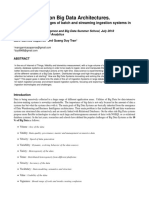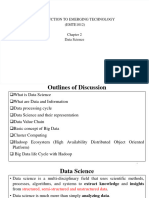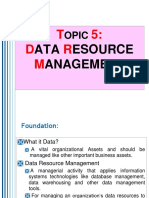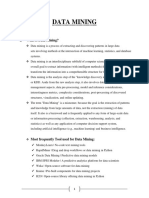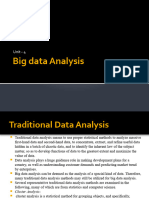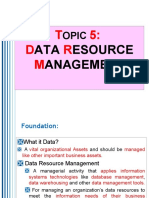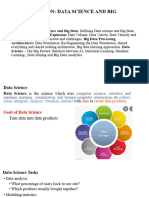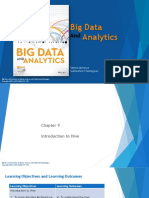0 ratings0% found this document useful (0 votes)
91 viewsIntroduction To Big Data: Fill in The Blanks
Introduction To Big Data: Fill in The Blanks
Uploaded by
Raghavendra Danadavar - 2BA17CS051This document provides an introduction to key concepts in big data, including:
- The three types of data are structured, semi-structured, and unstructured, with unstructured data making up 80-90% of organizational data.
- Common big data technologies and concepts discussed include relational databases, data mining algorithms, UIMA, ERP, CRM, data lakes, and CAP theorem.
- Companies should leverage big data to look at newer architectures, tools, and practices in order to gain insights from large and diverse datasets.
Copyright:
© All Rights Reserved
Available Formats
Download as PDF, TXT or read online from Scribd
Introduction To Big Data: Fill in The Blanks
Introduction To Big Data: Fill in The Blanks
Uploaded by
Raghavendra Danadavar - 2BA17CS0510 ratings0% found this document useful (0 votes)
91 views4 pagesThis document provides an introduction to key concepts in big data, including:
- The three types of data are structured, semi-structured, and unstructured, with unstructured data making up 80-90% of organizational data.
- Common big data technologies and concepts discussed include relational databases, data mining algorithms, UIMA, ERP, CRM, data lakes, and CAP theorem.
- Companies should leverage big data to look at newer architectures, tools, and practices in order to gain insights from large and diverse datasets.
Original Title
BDA1
Copyright
© © All Rights Reserved
Available Formats
PDF, TXT or read online from Scribd
Share this document
Did you find this document useful?
Is this content inappropriate?
This document provides an introduction to key concepts in big data, including:
- The three types of data are structured, semi-structured, and unstructured, with unstructured data making up 80-90% of organizational data.
- Common big data technologies and concepts discussed include relational databases, data mining algorithms, UIMA, ERP, CRM, data lakes, and CAP theorem.
- Companies should leverage big data to look at newer architectures, tools, and practices in order to gain insights from large and diverse datasets.
Copyright:
© All Rights Reserved
Available Formats
Download as PDF, TXT or read online from Scribd
Download as pdf or txt
0 ratings0% found this document useful (0 votes)
91 views4 pagesIntroduction To Big Data: Fill in The Blanks
Introduction To Big Data: Fill in The Blanks
Uploaded by
Raghavendra Danadavar - 2BA17CS051This document provides an introduction to key concepts in big data, including:
- The three types of data are structured, semi-structured, and unstructured, with unstructured data making up 80-90% of organizational data.
- Common big data technologies and concepts discussed include relational databases, data mining algorithms, UIMA, ERP, CRM, data lakes, and CAP theorem.
- Companies should leverage big data to look at newer architectures, tools, and practices in order to gain insights from large and diverse datasets.
Copyright:
© All Rights Reserved
Available Formats
Download as PDF, TXT or read online from Scribd
Download as pdf or txt
You are on page 1of 4
Big Data and Analytics - 1
Introduction to Big Data
Fill in the Blanks:
1 Firewalls of the Enterprise data is present in Homogeneous
sources As well as in Heterogeneous Sources.
2 Digital data can be classified into Structured,Semi-Structured
and Unstructured data.
3 Unstructured data is consist of 80-90% data of an
organization.
4 It does not confirm to a data model but ha some structure is
called Semi-Structured data.
5 Structured data is an Organized form and easily used by a
computer program.
6 Most of the enterprise data has stored in relational
databases.
7 Data held in RDBMS is typically Structured data.
8 Structure data generated an Object and Classes.
9 Predefined schema is called Structured data.
10 The number of tuples in a relation is called Cardinality of a
Relation.
Big Data and Analytics - 1
11 The number of columns referred as the Degree of a
Relation.
12 Expand ACID Atomicity,Consistency,Isolation,Durability.
13 Expand DML Data Manipulation Language.
14 Expand SOAP Simple Object Access Protocol.
15 Expand JSON Java Script Object Notation.
16 Popular data mining algorithms are Association rule
mining,Regression Analysis,Collaborative filtering.
17 Expand UIMA Unstructured Information Management
Architecture.
18 The relational data base evolved in 1980s & 1990s.
19 Todays big-data become tomorrow’s NORMAL
20 3 V’s concept proposed by the Gartner analysist Doug Lancy
in 2001 year.
21 Terabyte is 1024^4 bytes.
22 Expand ERP Enterprise Resource Planning.
23 Expand CRM Customer Relationship Management.
24 Why company should compulsorily consider leveraging big-
data to look at newer architecture,tools & practices.
25 Variability Characteristic of data explains the spikes in data
Big Data and Analytics - 1
26 Volatility is the characteristics of data dealing with its
retention.
27 Near real time processing or real time processing deal with
Velocity characteristics of data.
28 Data Lakes is a large data repository that stores data in its
nature format until it is need.
29 Variability data flow can be highly inconsistent with periodic
peaks.
30 Data science is the science of extracting knowledge from
data using Statistical & Mathematical techniques.
31 Raw data is just “RAW” unsuitable for Analysis.
32 Data access from non-volatile storage such as hard disk is a
slow process.
33 In database processing is also called in-databases analytics.
34 Symmetric Multiprocessor Systems are tightly coupled
multiprocessor system.
35 Distributed data systems are known to be loosely coupled
and are composed by individual machines.
36 CAP Theorem is also called Brewer’s Theorem.
37 Consistency implies that every read fetches the last write.
Big Data and Analytics - 1
38 Availability implies that reads and writes always succeed.
39 Partition tolerance implies that the system will continue to
function when network partion occurs.
40 A Shared Nothing Architecture provides the benefit of
Isolation fault.
You might also like
- Qualys AnswersDocument7 pagesQualys AnswersMunaam TariqNo ratings yet
- 2 Data ScienceDocument27 pages2 Data Sciencekigali acNo ratings yet
- Big Data and Data Science: Case Studies: Priyanka SrivatsaDocument5 pagesBig Data and Data Science: Case Studies: Priyanka SrivatsaYasir ButtNo ratings yet
- Unit-1-Part1-Big Data Analytics and ToolsDocument12 pagesUnit-1-Part1-Big Data Analytics and ToolsAlekhya AbbarajuNo ratings yet
- Ingestion Layer PDFDocument11 pagesIngestion Layer PDFAnonymous 3OMRz3VCNo ratings yet
- Chapter - 2 - Data ScienceDocument33 pagesChapter - 2 - Data ScienceDemekeNo ratings yet
- Chapter 2Document27 pagesChapter 2andualem werkinehNo ratings yet
- Big Data Analytics On Large Scale Shared Storage System: First SeminarDocument22 pagesBig Data Analytics On Large Scale Shared Storage System: First SeminarKyar Nyo AyeNo ratings yet
- Lecturer: Humaira Abdul Ghafoor: Lec 1 (Week 1) Sep, 2021Document33 pagesLecturer: Humaira Abdul Ghafoor: Lec 1 (Week 1) Sep, 2021WaleedNo ratings yet
- Bda Mod 1Document17 pagesBda Mod 1Ison PereiraNo ratings yet
- Data MiningDocument130 pagesData MiningabulgassimgNo ratings yet
- Ch-03-1 Unlocked 2Document45 pagesCh-03-1 Unlocked 2jzNo ratings yet
- Bda - 1 UnitDocument21 pagesBda - 1 UnitASMA UL HUSNANo ratings yet
- Chapter 2 - Intro. To Data SciencesDocument27 pagesChapter 2 - Intro. To Data SciencesYeabsira FikaduNo ratings yet
- Lecture 2 & 3 Database Systems I: Comsats University Islamabad, Wah CampusDocument42 pagesLecture 2 & 3 Database Systems I: Comsats University Islamabad, Wah CampusSyed IrtazaNo ratings yet
- BDA Module - 1 PSMDocument32 pagesBDA Module - 1 PSMprajna.sg241No ratings yet
- Big Data Analytics On Large Scale Shared Storage System: University of Computer Studies, Yangon, MyanmarDocument7 pagesBig Data Analytics On Large Scale Shared Storage System: University of Computer Studies, Yangon, MyanmarKyar Nyo AyeNo ratings yet
- MongoDB Top 7 NoSQL ConsiderationsDocument18 pagesMongoDB Top 7 NoSQL ConsiderationsMike Sia100% (1)
- LECTURE 3-Data Resource ManagementDocument44 pagesLECTURE 3-Data Resource ManagementFloe MakumbeNo ratings yet
- Part 1Document44 pagesPart 1suthojuakhil21No ratings yet
- Week 06 PDFDocument53 pagesWeek 06 PDFtanmoy8554No ratings yet
- Unit 5Document5 pagesUnit 5userdemo12334No ratings yet
- Data Warehousing and Data MiningDocument30 pagesData Warehousing and Data MiningDo Van Tu100% (1)
- IG System Task 7 Chapter 6Document12 pagesIG System Task 7 Chapter 6ScribdTranslationsNo ratings yet
- CH 2Document21 pagesCH 2BERHAN HAILUNo ratings yet
- An Approach To Analysis and Classification of Data From Big Data by Using Apriori AlgorithmDocument4 pagesAn Approach To Analysis and Classification of Data From Big Data by Using Apriori Algorithmanil kasotNo ratings yet
- Super Important Questions For BDADocument26 pagesSuper Important Questions For BDAAkhila R100% (1)
- Big DataDocument5 pagesBig DataAKASH S RNo ratings yet
- EmgTech Chapter 02Document51 pagesEmgTech Chapter 02Galaan HussienNo ratings yet
- Describe The Data Processing Chain: Business UnderstandingDocument4 pagesDescribe The Data Processing Chain: Business UnderstandingTHAATNo ratings yet
- Data Design & UsageDocument14 pagesData Design & UsageKhushboo NavinchandraNo ratings yet
- Module 5Document40 pagesModule 5Chris KellerNo ratings yet
- Unit 1Document11 pagesUnit 1Lokesh ReddyNo ratings yet
- Chapter 3 Review QuestionsDocument5 pagesChapter 3 Review QuestionsSarah GharaibehNo ratings yet
- What Is Big DataDocument24 pagesWhat Is Big DatayouyouNo ratings yet
- Lecture 02Document60 pagesLecture 02natnaelNo ratings yet
- Chapter 6 Management Information SystemDocument6 pagesChapter 6 Management Information SystemyogosaeNo ratings yet
- Big Data Analytics NotesDocument35 pagesBig Data Analytics Notesanaghayawale007No ratings yet
- What Is Difference Between Data Warehouse and Big DataDocument8 pagesWhat Is Difference Between Data Warehouse and Big Datakin bhNo ratings yet
- Course Work Database ProgrammingDocument18 pagesCourse Work Database ProgrammingVANNo ratings yet
- MC5403 Adbdm Unit I NotesDocument95 pagesMC5403 Adbdm Unit I NotesSivaNo ratings yet
- Relation Between Big: Data and BusinessDocument4 pagesRelation Between Big: Data and Businessعمار طعمةNo ratings yet
- Fdsa Unit 1Document25 pagesFdsa Unit 1Dr.ARTHEESWARI SNo ratings yet
- Infromation System1Document47 pagesInfromation System1gopal_ss4923No ratings yet
- 2 IntroductionToRDBMSDocument192 pages2 IntroductionToRDBMSSathish AramallaNo ratings yet
- Data Mining 1Document13 pagesData Mining 1Waleed RazaNo ratings yet
- Databases and Information ManagementDocument2 pagesDatabases and Information ManagementNadya AlexandraNo ratings yet
- Unit 1.1data Science Technology StackDocument87 pagesUnit 1.1data Science Technology Stackistarss9101No ratings yet
- Big Data AnalyticsDocument14 pagesBig Data Analyticshardik.dwivediNo ratings yet
- IV Unit Big Data AnalysisDocument17 pagesIV Unit Big Data Analysisgowrishankar nayanaNo ratings yet
- An Introduction To Data Warehousing and Data MiningDocument34 pagesAn Introduction To Data Warehousing and Data MiningAgnivesh PandeyNo ratings yet
- Introduction To Big Data-0Document77 pagesIntroduction To Big Data-0AbhishreeNo ratings yet
- Bigdata Unit1Document62 pagesBigdata Unit1SwethaNo ratings yet
- Database Management: Foundations of Computer Science à Cengage LearningDocument13 pagesDatabase Management: Foundations of Computer Science à Cengage LearningMustafa AdilNo ratings yet
- Chaoter Data ScienceDocument20 pagesChaoter Data SciencegaarummaayohaannisNo ratings yet
- WWW Doubtly in Big Data Analytics Semester 7 Mu Ai Ds Viva QnaDocument7 pagesWWW Doubtly in Big Data Analytics Semester 7 Mu Ai Ds Viva Qnasalehub7No ratings yet
- Big Data Analytics Project Proposal by SlidesgoDocument12 pagesBig Data Analytics Project Proposal by Slidesgoshuvampal23No ratings yet
- T 5: D R M: ATA Esource AnagementDocument49 pagesT 5: D R M: ATA Esource AnagementbayzidNo ratings yet
- Unit 1 Introduction: Data Science and Big Data: SyllabusDocument38 pagesUnit 1 Introduction: Data Science and Big Data: Syllabussunandanpt21020No ratings yet
- THE SQL LANGUAGE: Master Database Management and Unlock the Power of Data (2024 Beginner's Guide)From EverandTHE SQL LANGUAGE: Master Database Management and Unlock the Power of Data (2024 Beginner's Guide)No ratings yet
- Unit 4. Chapter 2 Threads: Creating Threads in PythonDocument10 pagesUnit 4. Chapter 2 Threads: Creating Threads in PythonRaghavendra Danadavar - 2BA17CS051No ratings yet
- Database 7Document2 pagesDatabase 7Raghavendra Danadavar - 2BA17CS051No ratings yet
- These Are The Records in Employee Table Before Delete: 34 - KAMALA - 55 - Female - PHD - 6000.0 - Professor - 02-05-1990Document9 pagesThese Are The Records in Employee Table Before Delete: 34 - KAMALA - 55 - Female - PHD - 6000.0 - Professor - 02-05-1990Raghavendra Danadavar - 2BA17CS051No ratings yet
- Relationship Between Two TablesDocument6 pagesRelationship Between Two TablesRaghavendra Danadavar - 2BA17CS051No ratings yet
- These Are The Records in Employee Table Before Update: 34 - KAMALA - 55 - Female - PHD - 1000000.0 - Professor - 02-05-1990Document11 pagesThese Are The Records in Employee Table Before Update: 34 - KAMALA - 55 - Female - PHD - 1000000.0 - Professor - 02-05-1990Raghavendra Danadavar - 2BA17CS051No ratings yet
- Big Data Analytics: Seema Acharya Subhashini ChellappanDocument47 pagesBig Data Analytics: Seema Acharya Subhashini ChellappanRaghavendra Danadavar - 2BA17CS051100% (1)
- Unit 4. Chapter 2 ThreadsDocument13 pagesUnit 4. Chapter 2 ThreadsRaghavendra Danadavar - 2BA17CS051No ratings yet
- Unit 4. Chapter 2 Threads: Thread SynchronizationDocument6 pagesUnit 4. Chapter 2 Threads: Thread SynchronizationRaghavendra Danadavar - 2BA17CS051No ratings yet
- MSB Candidate Guide - NPTEL PDFDocument16 pagesMSB Candidate Guide - NPTEL PDFMr.Bhaskar WabhitkarNo ratings yet
- STK411-220E: Details PDFDocument1 pageSTK411-220E: Details PDFOscar VazquesNo ratings yet
- Chatbot For Healthcare System Using AI - AshishDocument40 pagesChatbot For Healthcare System Using AI - Ashishaashishdhamala819No ratings yet
- Membership Application 22-23Document8 pagesMembership Application 22-23Hisham TariqNo ratings yet
- NREB Registered EIA Consultant - 31oct2021Document11 pagesNREB Registered EIA Consultant - 31oct2021carolNo ratings yet
- Compare Static and Dynamic RoutingDocument24 pagesCompare Static and Dynamic RoutingJose L. RodriguezNo ratings yet
- UOL SE LHR FYP Phase II Poster Template 2Document1 pageUOL SE LHR FYP Phase II Poster Template 2A D N A NNo ratings yet
- 1 - Construction ProcessDocument19 pages1 - Construction Processfaruq_basriNo ratings yet
- Snia PM Cs Summit Wang CXL ComputationalStorage 2021Document13 pagesSnia PM Cs Summit Wang CXL ComputationalStorage 2021jin xiaNo ratings yet
- Stability Test Diagram For Typical SubstationDocument3 pagesStability Test Diagram For Typical Substationajeez86100% (2)
- PSI Tier 3 Mobile Engine Fuel System Service Manual-I-1 PDFDocument351 pagesPSI Tier 3 Mobile Engine Fuel System Service Manual-I-1 PDFRenato Sanchez100% (2)
- Iot in AutomobilesDocument15 pagesIot in AutomobilesShubham BansalNo ratings yet
- Allen Bradley 1485 PowertapDocument2 pagesAllen Bradley 1485 PowertapRAFAEL CARDOSONo ratings yet
- Additional Notes DigicommDocument4 pagesAdditional Notes DigicommRoggen JokoNo ratings yet
- Operations Management SyllabusDocument4 pagesOperations Management Syllabusrcm921No ratings yet
- RF Electronic Programmable Room Thermostat, 7 Day Fitting InstructionsDocument2 pagesRF Electronic Programmable Room Thermostat, 7 Day Fitting Instructionspps g69No ratings yet
- Introduction of Robot Hollow JointsDocument36 pagesIntroduction of Robot Hollow JointsHamzaNo ratings yet
- 15.30 - Mario SanvitaleDocument23 pages15.30 - Mario SanvitaleNachiketa GuptaNo ratings yet
- Micro Project Report (English)Document13 pagesMicro Project Report (English)Chaitali KumbharNo ratings yet
- Letter For Personnel RequestDocument2 pagesLetter For Personnel RequestJeff Dy DuhaylungsodNo ratings yet
- PIC18 Microcontroller Instruction Set SummaryDocument6 pagesPIC18 Microcontroller Instruction Set SummarySammy Jaafar100% (1)
- Sophia RobotDocument10 pagesSophia RobotTUZA BAAPNo ratings yet
- GSPL Q3 2023-24 - CompressedDocument373 pagesGSPL Q3 2023-24 - CompressedAvinash MohapatraNo ratings yet
- 8086 Architectute 1Document50 pages8086 Architectute 1DILITH DINESHNo ratings yet
- Part 4 - Solar Systems Greater Than 425 KWPDocument26 pagesPart 4 - Solar Systems Greater Than 425 KWPganesamoorthy1987No ratings yet
- Comptia Cs0 003 2Document246 pagesComptia Cs0 003 2Nora the oneNo ratings yet
- Gigaset 3000 Comfort FullDocument30 pagesGigaset 3000 Comfort FullRajnai IvánNo ratings yet
- Tactical Plan: Linkedin Content MarketingDocument1 pageTactical Plan: Linkedin Content MarketingIan TanpiucoNo ratings yet




